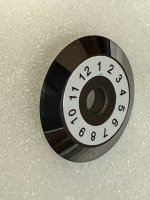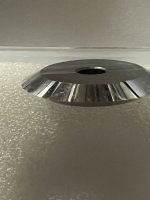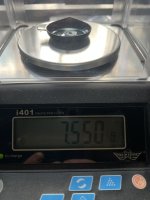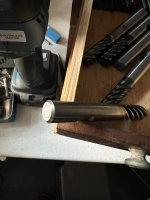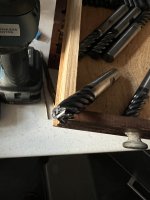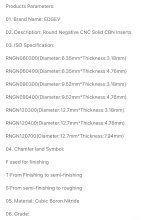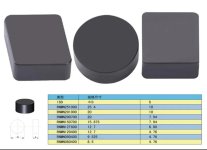Hi Sether,
The 1mm steel forms the base of the rail not the carriage. I did not quench harden it though this may have been beneficial. I was more concerned with avoiding heat induced distortion. Keeping the base completely flat was of great importance. I do not remember the grade of steel used. It was quite expensive and a pig to work with. Hacksaws didn't touch it.
Niffy
The 1mm steel forms the base of the rail not the carriage. I did not quench harden it though this may have been beneficial. I was more concerned with avoiding heat induced distortion. Keeping the base completely flat was of great importance. I do not remember the grade of steel used. It was quite expensive and a pig to work with. Hacksaws didn't touch it.
Niffy
It is normal preferably to have the vee harder than the pivot.
If the radius of the pivot is reasonably large and the radius of the vee is kept to around twice that of the pivot you should be fine using diamond pivots in sapphire vees.
If the pivot has a radius of less than 0.06mm or the ratio between the pivot and vee is greater than 2.5 you might have problems. This will also be dependent on carriage mass, I'm assuming around 60g fully loaded.
Niffy
If the radius of the pivot is reasonably large and the radius of the vee is kept to around twice that of the pivot you should be fine using diamond pivots in sapphire vees.
If the pivot has a radius of less than 0.06mm or the ratio between the pivot and vee is greater than 2.5 you might have problems. This will also be dependent on carriage mass, I'm assuming around 60g fully loaded.
Niffy
I’ll weigh them tonight, yes solid carbide 4.00mm ID so might be able to machine an axle to take the 1/8” diamond engraving tips. Quite a thin wall but possible. I’m working on a skeletal carriage with two keel ballast chambers to counteract the wheel weight and to accurately set the COG.
S.
S.
With my wheels I made the axle slightly smaller than the hole in the hub. I aligned the wheel with the pivots using two jigs. One that measured how far off the alignment was and one that allowed me to move the hub relative to the axle. This way any inaccuracies in any of the sub-assemblies could be adjusted out. Unfortunately I don't have pictures of the jigs.
Niffy
Niffy
My new wheels will be 16mm OD. I only need to lower the COG about 0.5mm a 5mm lift of the stylus lowers VTF by 0.3g so it's very close. The new wheels are being CNC machined from M200 tool steel in one piece, they will be ground, polished then hardened and re-polished, so I'll see how they go. I need to lower the mass the wheels as the entire wheel is above the pivot.
@warrjon if you’re having wheels made why not cut the end off a broken 16mm TC end mill with a CBN diamond lathe tool. I work with stainless a lot and these are notoriously brittle. Tend to break one of two ways, wrong feed rate or when changing the tool they fall out of the collet onto the mill table! Any machine shop will have a bucket of these with the good intention of having them reground but it never happens!!
S.
S.
My new wheels will be 16mm OD. I only need to lower the COG about 0.5mm a 5mm lift of the stylus lowers VTF by 0.3g so it's very close. The new wheels are being CNC machined from M200 tool steel in one piece, they will be ground, polished then hardened and re-polished, so I'll see how they go. I need to lower the mass the wheels as the entire wheel is above the pivot.
Hi Warren,
Looks like you're pretty much there on the height of the COG. A real world warp would reduce VTF by a tiny fraction of the measured 0.3g.
When you say the wheels will be machined from a single piece is that the rims, hubs, axles and pivots or are you going to have tungsten carbide inserts for the pivots? I'm looking forward to seeing what you have in mind. I'm picturing something that looks like the spinning top from the film Inception but symmetrical, though this wouldn't be the lowest mass design.
Niffy
Hi Warren,
Looks like you're pretty much there on the height of the COG. A real world warp would reduce VTF by a tiny fraction of the measured 0.3g.
When you say the wheels will be machined from a single piece is that the rims, hubs, axles and pivots or are you going to have tungsten carbide inserts for the pivots? I'm looking forward to seeing what you have in mind. I'm picturing something that looks like the spinning top from the film Inception but symmetrical, though this wouldn't be the lowest mass design.
Niffy
We're going to try a fully one piece and see how they perform. If they end up too heavy then we'll redesign the wheels with aluminium or titanium hubs. When I get the prototype I'll post a pic and details.
In my case sapphire wheels were ruled out because they are difficult to machine. I am building 3 inverted bearing Technics SP10's with linear tracking tonearms and we need a solution that is easily repeatable. The wheels will be machined on a $300k 5 axis CNC before being ground on another CNC cylindrical grinder. M200 tool steel is not off carbide for hardness especially with minimal tempering.
I still like the sapphire wheel idea.
S.
I like the idea of the Sapphire windows as wheels. They seem to be quite affordable.
There are a couple of potential issues.
The windows might not be very round.
The corners appear very sharp. They would need to be slightly rounded and highly polished.
There is no hole through which the axle can pass. A hole would need to be drilled with a diamond drill bit. This should be possible but I have no idea how easy this would be. Alternatively hubs would have to be glued to either side of the window. Getting the hubs perfectly aligned would be challenging.
Sapphire wheels on tungsten carbide rods should offer very low rolling resistance.
Niffy
Hi Sether,
The carbide rings were available either as "domed" which had a roughly semicircular cross-section or "square" which had a more rectangular cross-section. The outer face is still slightly convex and the corners rounded.
I made wheels with similar profiles to both from 2mm stainless steel. Measured rolling resistance was very similar between the two. The difference in subjective sound quality was not huge but I definitely preferred the square profile. It being more precise sounding, more immediate.
The edge radius of both the stainless steel wheels and the tungsten carbide rings was around 0.15mm.
I didn't try multiple different edge radii, just the two.
I hope this helps.
Niffy
The carbide rings were available either as "domed" which had a roughly semicircular cross-section or "square" which had a more rectangular cross-section. The outer face is still slightly convex and the corners rounded.
I made wheels with similar profiles to both from 2mm stainless steel. Measured rolling resistance was very similar between the two. The difference in subjective sound quality was not huge but I definitely preferred the square profile. It being more precise sounding, more immediate.
The edge radius of both the stainless steel wheels and the tungsten carbide rings was around 0.15mm.
I didn't try multiple different edge radii, just the two.
I hope this helps.
Niffy
I mentioned CBN for machining TC. There are a range of inserts for indexable lathe tools. One particular sort are circular which could perhaps make good wheels. These would be very accurate, maybe more so than the sapphire windows. See pic
S.
S.
Attachments
The advantage of tungsten carbide is its extreme hardness. Generally the harder the materials the wheels and rail are made from the lower the rolling resistance will be.
The disadvantage of tungsten carbide is its very high density, over 15g/cc. The entire wheel will be above the pivot point. Ideally we want the COG of the entire carriage (Inc cartridge, counterweight and wheels) to be level with the pivot point. We also want the pivot point to be as close to the record surface as possible in order to minimise warp induced wow.
If the wheels are very heavy the pivot point will need to be raised so that COGs of the cartridge and counterweight can be further below the pivot, balancing the carriage. This will worsen warp wow.
Making the wheels from solid tungsten carbide will result in the wheels being very heavy, raising the COG of the carriage.
Making only the rims from tungsten carbide and the wheels from a lighter material will result in the same low rolling resistance as solid tungsten carbide but with much lower overall mass.
(Although processes like anodising and nitriding will harden the surface of a wheel or rail the hardened layer is very thin, in the order of microns, and will not improve rolling resistance significantly. A rim made from a ring of material can be over a millimetre thick and will be much more effective.)
Sapphire does have the advantages of being even harder than tungsten carbide and having density almost a quarter of it. It has the major disadvantage of being almost impossible to work on in the average diy workshop.
Overall any design is going to be a compromise between weight, hardness, ease of machinability and processing, material availability and cost.
I got very lucky with my tungsten carbide rings
Niffy
The disadvantage of tungsten carbide is its very high density, over 15g/cc. The entire wheel will be above the pivot point. Ideally we want the COG of the entire carriage (Inc cartridge, counterweight and wheels) to be level with the pivot point. We also want the pivot point to be as close to the record surface as possible in order to minimise warp induced wow.
If the wheels are very heavy the pivot point will need to be raised so that COGs of the cartridge and counterweight can be further below the pivot, balancing the carriage. This will worsen warp wow.
Making the wheels from solid tungsten carbide will result in the wheels being very heavy, raising the COG of the carriage.
Making only the rims from tungsten carbide and the wheels from a lighter material will result in the same low rolling resistance as solid tungsten carbide but with much lower overall mass.
(Although processes like anodising and nitriding will harden the surface of a wheel or rail the hardened layer is very thin, in the order of microns, and will not improve rolling resistance significantly. A rim made from a ring of material can be over a millimetre thick and will be much more effective.)
Sapphire does have the advantages of being even harder than tungsten carbide and having density almost a quarter of it. It has the major disadvantage of being almost impossible to work on in the average diy workshop.
Overall any design is going to be a compromise between weight, hardness, ease of machinability and processing, material availability and cost.
I got very lucky with my tungsten carbide rings
Niffy
- Home
- Source & Line
- Analogue Source
- DIY linear tonearm
